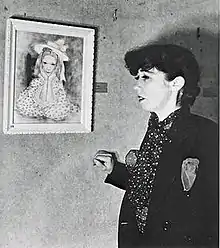Julia Thecla
Julia Thecla (February 28, 1896 – June 29, 1973) was an American artist based in Chicago in the 1930s and 1940s, working in the Surrealist and magical realist school of modern art.
Julia Thecla | |
|---|---|
 | |
| Born | Julia Thecla Connell February 28, 1896 Delavan, Illinois |
| Died | June 29, 1973 (aged 77) Chicago, Illinois |
| Nationality | American |
| Known for | Painting |
| Movement | Magical Realism, Surrealism |
Early life and education
Thecla was born Julia Thecla Connell in the small town of Delavan, Illinois, the second-youngest of five children. Her artistic talents were evident early on, and she won first prize in a county drawing contest at age 12.[1] After graduating from Delavan High School in 1913, she studied at Illinois State University in Normal for a summer.[1] The university was then primarily a teacher's college, and due to high demand it was common for prospective teachers to study only for as long as they felt was needed to prepare themselves; Thecla subsequently taught students in the first through seventh grades at a rural schoolhouse in Tazewell County.[1]
Around 1920, in her early 20s, she moved to Chicago, broke off ties with her family, and began using Thecla as her surname.[2] She told various stories to explain the change.[1] She studied for a total of two years at the School of the Art Institute of Chicago, periodically breaking off her studies to work.[1]
Artistic career
Thecla was primarily a watercolorist, and made extensive use of fantasy imagery; her work was often described as "jewel-like" or "enchanted".[3] She worked almost exclusively with the female form, frequently using herself as a model.[3]
Thecla's work was exhibited for the first time in 1931, at the annual International Watercolor Exhibition at the Art Institute of Chicago.[1] Her works were subsequently exhibited there every year until 1936, and again from 1940 to 1944.[4] Her work began to be shown nationwide in the 1940s, beginning at the Museum of Modern Art in New York City in 1943.[1] Also in 1943, Thecla was included in Peggy Guggenheim's show Exhibition by 31 Women at the Art of This Century gallery in New York.[5]
To support herself, Thecla periodically took paying work as an industrial artist, office worker, or art restorer; her work in restoration gave her skills in detail work that she also applied to her painting.[1] From 1938 to 1942, she was employed by the Federal Art Project, a branch of the Works Progress Administration, in the "easel division".[3]
Thecla wrote poetry throughout her career, but only published one poem during her lifetime, as she felt that poetry was a private affair.[1] Her poems were lost when she was moved out of her home in 1969.[3]
Later life and legacy
After the mid-20th century, Thecla's work was largely forgotten.[2] Reasons for this included the rising interest in abstraction, and the generally lower level of attention given to women artists, particularly those not associated with men.[2] In addition, she had come to be viewed by many as mentally unstable, although later researchers have disputed this characterization.[2] Nonetheless, Thecla continued painting until her vision began to deteriorate in her seventies.[2] In 1969, she was forced to vacate the apartment where she had lived for many years due to renovation, and in the process she lost many of her possessions and supplies.[3] She stayed with friends and family for a time, but in 1971 she was moved to a nursing home, and died there in 1973.[2][3]
As of 2012, five of Thecla's works are held by the Art Institute of Chicago, although none of these are publicly displayed.[6] The Chicago History Museum also owns one of Thecla's paintings.
In 2006, 35 Thecla paintings were shown in a special exhibit at the DePaul University Art Museum.[7] The museum described Thecla as a forgotten Chicago artist, saying "her ethereal and sensuous portrayal of dreams, fairytales, and planetary realms were extraordinary explorations of alternative social orders."[7]
Works cited
- Holm, Erica L. (2001). "Thecla, Julia". In Schulz; Hast (eds.). Women Building Chicago, 1790-1990. Indiana University Press. pp. 873–875. ISBN 0253338522.
References
- Holm 2001, p. 873.
- Ruth Lopez (2005-03-22). "Remembering Julia Thecla". Time Out Chicago. Retrieved 2012-10-27.
- Holm 2001, p. 874.
- "Julia Thecla". Illinois Women Artists Project. Bradley University. Retrieved 2012-10-27.
- Butler, Cornelia H.; Schwartz, Alexandra (2010). Modern Women: Women Artists at The Museum of Modern Art. New York: Museum of Modern Art. p. 45. ISBN 9780870707711.
- "Thecla, Julia". Art Institute of Chicago. Retrieved 2012-10-27.
- DePaul Art Museum. "Julia Thecla: Undiscovered Worlds". Retrieved 2012-10-27.